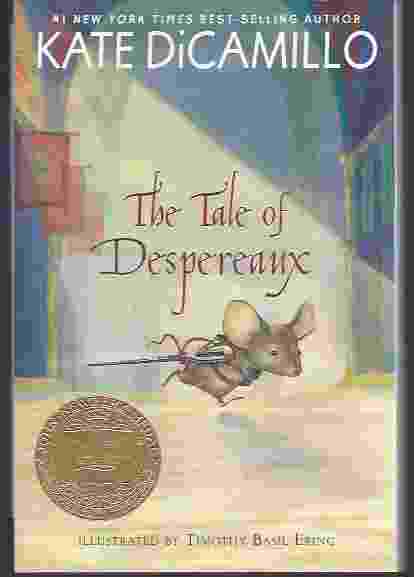
Full disclosure: The odds were stacked against Kate DiCamillo's The Tale of Despereaux (2003), before I ever cracked it open. How could I give an honest review when I'd seen the movie version first? That wasn't even the biggest problem. The basic story is about a mouse seeking adventure even as his family warns him against it - the same concept behind my Otter and Arthur books.
Then again, this was the winner of the 2004 Newbery medal. In fact, she's one of the few two-time winners, just nabbing the award again in 2014 for Flora and Ulysses. I'd also read her Mercy Watson series with my son and we loved them.
For those unfamiliar with the story, Despereaux is a mouse who neither looks nor behaves like he's "supposed" to. He's unnaturally small, has unnaturally large ears, and has an unnaturally over-sized curiosity. Against the basic mouse code, he interacts with a human - the Princess Pea - and gets banished to the castle dungeon, betrayed by his own family "ratting" him out.
A rat, Roscuro, figures prominently in the story as well. However, one hopes the rat might take a similar path as Despereaux and want to rise above his kind. He doesn't. Similarly, Miggery Sow, a not-so-bright orphan girl who dreams of being the princess, proves to be of less redeemable character.
The book divided into full sections devoted to each of the above characters. This proves its biggest flaw as we care about Despereaux's fate much more than Roscuro or Miggery Sow. While the stories all weave together in the end, the explorations into the latter two characters feels like a distraction initially. I'll have to watch the movie again, but I don't remember this being a distraction for me there.
In my own writing, my Otter and Arthur series focuses in on a mouse whose quest for adventure leads him to befriend King Arthur. However, the story remains focused at all times on Otter, as it is completely told from his perspective.
On the flip side, however, my latest novel, Abigail's Atlantis, weaves two stories together. The challenge is to get the reader to care about two main characters in two different stories. What have I learned about doing so after reading Despereaux? People have to care about the characters. A character who is drawn too unsympathetically can lose an audience. In Despereaux, the reader is curious about what will happen to these characters, but their stories are slightly underminded with a certain sense of "these characters deserve whatever's coming to them." With Abigail's Atlantis, it is important that readers root for both of my main characters. As such, I will strive to craft a story where people care about my characters.














